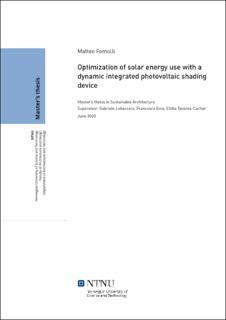| dc.description.abstract | Integrasjon av solceller på bygningskroppen har fått stadig økende oppmerksomhet de siste tiårene. Strengere krav til energieffektivitet har fremmet utviklingen av nye produkter, som har mulighet til å løse flere problemer samtidig. Denne masteravhandlingen skal ta for seg potensialet ved bruk av solceller med integrerte solavskjerming( PVSDs), ved å foreslå en metode som kan vurdere fordeler ved bruk av dynamisk solavskjerming fremfor statisk. Analysene vil bli foretatt for forskjellige tidskarakteriseringer i tillegg til lokasjoner med ulik breddegrad. Optimaliseringen gjennomføres gjennom en MOO-tilnærming (multi-objective optimiastion), der målet er å redusere totalt energiforbruk og at samtidig tilstrekkelig dagslys blir opprettholdt. Testene er gjennomført i et enkelt kontor med solavskjermings anordning på to vinduer som er orientert mot sør. Resultatet fra studien viser en generell forbedring for alle breddegrader ved bruk av et dynamisk system, spesielt der det er økning i tidskarakteristikken gjennom året. Funnene som vekker størst oppsikt er ved lavere breddegrader, der nivået på optimaliseringen kan nå opp mot 20%. Simuleringsprogrammet Ladybug for Grashopper har blitt benyttet, fra geometriskapning til energisimuleringer. Målet med denne masteravhandlingen har vært å åpne opp for vider utvikling for PVSDs, samt undersøke hovedtrekkene ved å ta i bruk dynamiske systemer. | |
| dc.description.abstract | The integration of photovoltaics on the buildings’ envelopes is getting increasing attention in the last few decades. Stringent energy regulations have led to the development of new products, responding to multiple functions simultaneously. This thesis investigates the potential of photovoltaic integrated shading devices (PVSDs), by proposing a methodology to assess the advantages of a dynamic shading system over a static one, for different time characterisations and latitudes. The optimisation is carried out through a multi-objective optimisation (MOO) approach, having as objectives the reduction of total energy consumption and an adequate level or internal natural daylight. A simple office room, with the shading devices installed on the two south-oriented windows, is used as test geometry to perform the analysis. The study demonstrates an overall improvement at every latitude by adopting a dynamic system, especially when the frequency of changes in the orientation of the system increase along the year. The most remarkable results are visible at lower latitudes, where levels of optimisation higher than 20% are obtained. The entire study, from the geometry creation to the energy and daylight simulations, was conducted inside the Grasshopper environment, using the Ladybug Tools as software packages. The final aim of the thesis is to contribute to broadening the potentialities on PVSDs, as well as drawing general outlines, valid when considering the adoption of a dynamic system of this kind. | |
